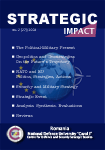STRATEGY FOR AFGHANISTAN
STRATEGY FOR AFGHANISTAN
Author(s): Mircea MureşanSubject(s): International relations/trade, Security and defense, Military policy, Peace and Conflict Studies
Published by: Carol I National Defence University Publishing House
Keywords: cooperation; strategic communications; terrorism; stability; reconstruction; leadership; partnership;
Summary/Abstract: The prolonged delay of the insecurity situation in Afghanistan, regardless the impressive presence of the allied and partner forces, has been the reason why this “hot subject” was considered of outmost importance on the agenda of the NATO Summit, Bucharest, April, 2-4, 2008. The decisions that have been made design the Strategic Vision of the International Security Assistance Force (ISAF), which will offer, through the underlined proposals, a wider contribution to the peace and reconstruction of this country. The proposals took the form of a concrete and immediate engagement, which represents the acceptance of certain major risks in ensuring security of a conflict region that has never been safe. The present analysis concentrates on the solutions found to make ISAF mission more effective, through the Strategy for Afghanistan: NATO and its partners’ engagement to continue the long-term efforts to secure and rebuild the country. The people of Afghanistan will be more responsible and its leadership will be reinforced. It will be offered support in building up, training and endowing of Afghan armed forces made up of 80,000 persons until 2010. The international community will offer a global support, thus combining the military and civilian efforts, for a better coordination, a cooperation and engagement with its neighbours, especially with Pakistan. The extremist propaganda will be discouraged and the communication with the Afghan and international public opinion will be improved.
Journal: Strategic Impact
- Issue Year: 2008
- Issue No: 27
- Page Range: 11-16
- Page Count: 6
- Language: English

